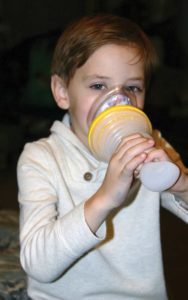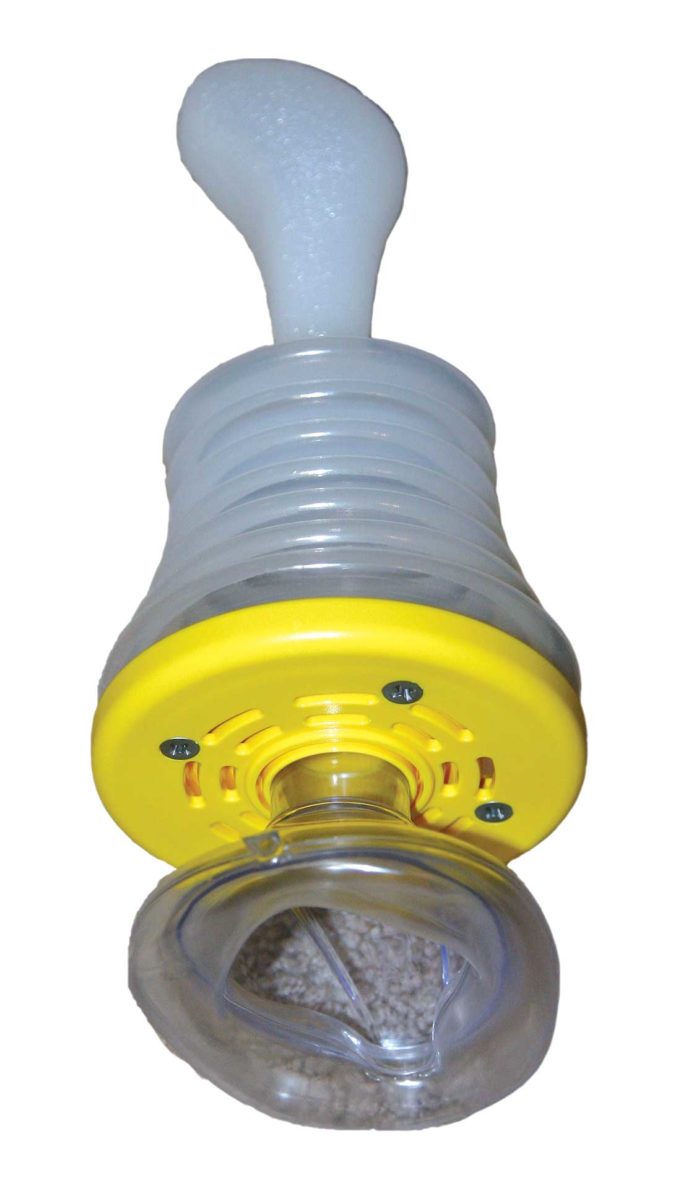Last summer, Quade was sucking on a Lemonhead hard candy when it lodged in his throat. His face turned red. He couldn’t breathe. His mother, Jennifer, was in another room but heard her daughter asking Quade if he was OK. The mother of three kids knew what to do. Her father taught CPR for years as a firefighter in Kennedale, and Jennifer was trained long ago.
This time, however, back blows and abdominal thrusts didn’t work on 5-year-old Quade. A desperate Jennifer tried Plan C –– a LifeVac device.
Jennifer — who asked that the family’s last name be withheld for security reasons — had purchased the LifeVac more than a year earlier but had never used it. The LifeVac is similar in concept to a plunger but designed to suck objects out of people’s windpipes should the traditional efforts fail to work. The basic principle of suction is old as time, but the LifeVac has been available to consumers only in the past few years.
Jennifer had read a story about a little boy choking to death and began searching online for precautions. Jennifer’s kids are 3, 6, and 9. All have choked on something at some point, she said, but she has been able to clear the obstructions through backslaps.
“Facebook is kind of crazy,” she said. “It starts popping things up after you’ve been researching something. A LifeVac ad popped up. I looked into it. I’m not somebody who just buys things. As a parent, you have to justify. Do I really need something I’m not sure I’m going to use or not? I sat there for a couple of weeks and kind of went back and forth and finally said, ‘You know what? We spend more on a dinner on the town, so I’m going to go ahead and get it.’ It was the only thing that saved my kid. Obviously, for me, it’s a huge thing.”
The device had sat on top of her refrigerator for a year and a few months.
Last week, Jennifer, her husband, and their children invited me into their home and explained how everything went down that day. A frantic Jennifer was working on Quade and sent daughter Quincey to grab the LifeVac, but the girl couldn’t find it. Jennifer ran into the kitchen, grabbed it, and stuck it onto her boy’s face. Quade, who was panicking, knocked it off before Jennifer could push the lever.
“The second time I did it, it popped out the candy immediately, and he threw up everywhere,” she said.
In minutes, he was feeling fine.
“He was breathing, and everything was great,” Jennifer said. “We were all scared and crying.”
She said the device was “really easy to use.”
“We’ve had to call [a first responder] before on a different incident, and it took them over 20 minutes to get to our house,” she said, noting that they live in rural Alvarado. “I knew there was no way that anyone could get there to save him.”
She wanted to share the incident on Facebook, but her husband was apprehensive. He isn’t a fan of social media.
“He didn’t understand why I felt the need to share it,” Jennifer said. “I’m like, ‘Babe, if our story could help somebody else in that same situation, when they can’t get [stuck food] out, I would feel so good about that.’ As a mom, I want to know what’s good –– the best car seat, whatever.”
He agreed. The post went up. Jennifer couldn’t believe the response.
“It kind of went viral,” she said. “It went crazy.”
Her Facebook page is private, and friends asked if they could share the post on their public pages. Jennifer agreed after removing Quade’s photo. She estimated her post was shared more than 1,000 times.
“One of my friends, her father is one of the regional managers at Pinnacle Bank,” Jennifer said. “He said, ‘I’d love to get these in the Cleburne schools.’ I said, ‘Yeah, let’s try to do that.’ ”
Jennifer taught in Cleburne schools for 10 years, and her husband is a third-generation teacher there.
“I met with some of the staff and showed them the device and told our story,” Jennifer said. “They went through several committees and meetings and checked all their peer-reviewed journals. Obviously, you have to do that when you’re a school district.”
Around that time, Jennifer received a call from someone she knew at a local paper telling her that “some weird guy” had contacted the paper to say LifeVac might have paid Jennifer to make her claims.
The man’s name was Peter Heimlich. Yes, his last name is notable. Peter’s father, Henry, is the namesake of the Heimlich maneuver, the celebrated method of dislodging of obstruction from a person’s windpipe by applying sudden pressure to the abdomen.
Heimlich isn’t a fan of the LifeVac.
Jennifer and her spouse were angry.
“When something like this happens, instead of calling the people that it happened to, he calls the paper and says these people are lying and these people are paid off,” Jennifer said. “We don’t know anyone in New York [where LifeVac is based]. We were born and raised in Johnson County. I have my receipt where I got [the device] on PayPal. I don’t know how many other papers he’s called, but not one time did he try to call me. That’s why when I say parents are apprehensive about posting stuff, it’s because of people like him. He doesn’t have a dog in the fight. I don’t know why he’s going out and trying to discredit choking devices and the people who use them.”
I asked her if she had been paid to promote LifeVac.
“Absolutely not,” she said. “There is no money. If there is something awesome, as a parent, I tell other parents about it.”
In October, she appeared on what might be described as an infomercial alongside LifeVac inventor Arthur Lih on a news channel broadcast in New York. Lih, of Long Island, reimbursed her travel expenses only, she said.
“I wasn’t paid to do that,” she said. “I would not tell people to do something had I not used it. I am a completely 100-percent legitimate person. I don’t accept any money from anybody. I wish I was getting paid for it. I advertise the crud out of it, and I’m sure I’ve sold a ton of units for them just from word of mouth alone.”
•••••
Even a man who says he wants to save a million lives must first face down his online critics. Lih invented a gadget that he is certain will keep people from choking to death, and the $70 device is making its way slowly into North Texas schools.
Quade’s near-death prompted a local bank executive to donate the safety devices to Cleburne schools recently. Tim Whitlock, regional president at Pinnacle Bank, challenged other branches to donate LifeVacs to schools in their areas. So far, Pinnacle Bank has made donations to the school districts in Burleson, Joshua, and Glen Rose, and Grandview’s have been ordered.
“We have reached out to other schools in our general area,” he said, “and they are going through the approval process with their school boards.”
LifeVac is a “simple and affordable device that can certainly save the day,” he said, adding that Pinnacle wants to help supply them to Fort Worth’s approximately 150 campuses. So far, the bank has provided more than 120 devices to more than 40 schools.
Whitlock is among those spreading the word in news reports and social media. Lih said he was inspired to create the prototype in his garage after hearing about a 7-year-old child choking to death on a grape. Lih’s daughter was the same age at the time, and the thought of her choking was so upsetting to Lih that he set out to develop a remedy.
His plastic contraption contains a mask and one-way valve system. Place the mask over the choking victim’s nose and throat and push down on a lever. Pull back up on the lever, and a powerful suction is created.
“I made it, and it worked,” Lih said.
He founded a company with a handful of employees to market his invention worldwide.
“I knew I could save my daughter,” Lih said, “but what kind of human sits there and says, ‘I’m good, but your kid has to die’?”
More than 150,000 people choke to death each year worldwide, about 5,000 of them in the United States. Lih vowed to mass-produce his invention, flood the world with them, and save a million lives before he’s done.
“I prayed and said, ‘Alright. I’m going to do it –– it’s going to be virtually impossible, but I can’t not do it,’ ” he recalled.
His lack of a medical background set him up for skepticism, and he faced large hurdles in convincing first responders to buy into a new product that mimics long-practiced CPR methods. Peer-reviewed studies and tests were hampered by a simple fact –– the device can’t be tested on live humans in a controlled environment. That leaves Lih touting anecdotal cases that he’s heard about, mostly on social media.
Inventing the life-saving device was easy compared to convincing skeptics that a face plunger works safely. He has sold about 100,000 units, mostly to worried parents, he said. Winning over emergency workers has been slow, although about 200 police and fire stations are stocking them, he said. About 500 schools stock them, and another 2,000 can be found in elder care homes, he said.
Moving 100,000 units has been made tougher by the dogged criticism from a medical watchdog –– an independent blogger with a famous last name.

•••••
If you were the type to jump to conclusions, you would think a medical watchdog named Peter Heimlich might criticize LifeVac because it’s considered another option –– kind of like a competitor –– to the Heimlich maneuver. It makes sense that Peter would protect his father’s legacy.
But not quite.
Peter Heimlich and his wife, Karen Shulman, run the MedFraud website and The Sidebar blog page and have spent two decades investigating scams. One of their most high-profile cases involved exposing Peter’s father, Henry Heimlich, as a charlatan. In 2007, Peter told a reporter that his dad never invented anything “but his own mythology.” His dad was a narcissist and fraud who stole credit for his namesake maneuver in the 1970s and perpetuated many other fabrications and publicity schemes during his lifetime, Peter said.
Early on, Henry promoted his famous maneuver by denouncing back blows –– the traditional method of clearing air passageways. He characterized them as “death blows,” saying they could drive objects deeper into a choking person’s windpipe and do more harm than good.
Beginning in 1986, the American Red Cross changed its choking protocol from backslaps first to the Heimlich maneuver. In 2006, four years after Peter had begun exposing his father, the humanitarian organization changed references to the “Heimlich maneuver” to “abdominal thrusts” and recommended using back blows first. Peter has a sister and brother who continue to support and promote their father’s work.
Henry died in 2016.
In January, I began corresponding with Peter Heimlich after an article in a Cleburne paper described how Pinnacle donated the LifeVacs. Heimlich has questioned the safety and effectiveness of Lih’s invention from the beginning. In 2016, New York’s Department of Education declared it did not recommend the LifeVac, effectively removing them from campuses after Heimlich questioned whether the device had been properly tested and approved.
Heimlich preferred to be interviewed by email rather than phone and told me he has no medical credentials but has done much research and reporting on various anti-choking devices.
“As a result of researching my dad’s bizarre career, I got interested in anti-choking devices that have been marketed over the decades,” Heimlich said. “The LifeVac, which is being marketed in the U.S. and abroad, is the highest-profile one I’ve come across.”
His blog page maintains a compilation of published warnings by medical and governmental authorities and expresses concerns about the lack of research proving the device’s safety and effectiveness.
“Since sports gear for high school athletes –– like football helmets –– are required to meet performance and safety guidelines, presumably rigorous standards should also be applied to medical devices used on young people,” he said.
Views are mixed among people in the emergency field.
In 2016, Courtney Bruegmann’s 9-month-old son Camynn died after choking on a rubber ball. Bruegmann could see the ball in his throat but couldn’t pull it out in time, and backblows hadn’t worked.
“The ball was right there, and we just couldn’t get it out,” she said.
She heard about the LifeVac afterward, she said, and bought five devices for her home and car from Amazon. She called Nate Flynn, chief of the Fennimore Area Rescue Squad, and offered to donate devices to the emergency crews.
“He told me I couldn’t do that because it had to go through a board and be approved by the state,” she said.
Less than two years later, the Wisconsin Department of Health Services and the state medical director approved the device after scrutinizing data provided by Lih. Still, emergency workers in Wisconsin “exhaust all other efforts of known airway obstruction skills and procedures based on our level of licensure before using the device,” Flynn wrote in an email.
None of his crewmembers have used the device in a real-life scenario yet, although they’ve been trained, Flynn said. The LiveVac is “just adding a tool to our toolbox,” he said.
A critic of that tool, however, is Marc Cohen, executive director of the Wisconsin EMS Association. The group represents thousands of members with ambulance services and first responder organizations. Cohen said he heard from Lih after Camynn Bruegmann’s death. Lih asked Cohen’s group to endorse his product, and Cohen thought the call odd and Lih’s tactics questionable.
“He was looking to use our endorsement as a marketing tool,” Cohen said. “His goal is to scare schools and communities and states to get them to pass legislation to force funding to put these devices in every school. There were no tests, no data that could qualify this as a primary life-saving device.”
To Cohen, Lih appeared to be bypassing traditional vetting by clinicians, physicians, and emergency workers while trying to secure endorsements from emergency workers to convince consumers that the LifeVac works.
“We can’t come out and say it doesn’t work,” Cohen said. “We don’t know, but it’s not something we’re going to actively seek out to encourage our services in the state to add this to a list of protocols.”
Lih traveled to Fennimore to meet the Bruegmann family and hold a press conference, which also troubled Cohen.
“These are distraught parents who had lost a child,” Cohen said. “It seemed inappropriate.”
Courtney Bruegmann, though, is a fan of Lih and the LifeVac and isn’t being paid to say so, she said.
“He just is sick of hearing about these kids dying and wanted to see if there was something he could come up with that prevented it,” she said. “He is very passionate about it. You can definitely tell it’s not about the money. It’s about saving somebody’s life and their not having to experience what we went through. Our mission, too, is letting people know about it so they don’t have to go through what we went through. Seventy dollars for a LifeVac is a lot cheaper than paying for a funeral.”
I called Lih to discuss the criticisms. First, though, he asked me a couple of questions. Had Heimlich contacted me? And did I know Heimlich previously? Lih said most any time he introduces LifeVac to a new school, retirement home, or first responders and earns publicity, he can bet Heimlich will send emails to people involved to express his concerns.
Lih said he appreciated Heimlich’s input early in the process. The watchdog’s constructive criticisms, however, evolved into unfounded accusations, Lih said, such as being accused of paying people to say that LifeVac had saved a loved one’s life. Lih said he has never paid anyone for a testimonial.
Heimlich’s scrutiny began with “legitimate concerns that were good,” Lih said. “Is it tested? Is it this? Or that? The problem was, as we accomplished these things –– we got medical journals, we got fire departments, we got testing, we got saves –– it kind of shifted into saying I’m paying people off. I don’t know why he moved to the lying phase. I think he’s running out of legitimate things to say.”
Some problems trace back to Lih. He promoted supportive studies by the American Journal of Gastroenterology and The World Congress of Gastoenterology that were co-authored by Dr. Lisa Lih-Brody, but Lih didn’t think to mention that Lih-Brody was his sister. Using a familial relationship like that could be considered unethical, although Lih said the bloodline doesn’t change the fact that his sister is a successful and prominent New York-based gastroenterologist.
Also early on, Lih touted a cadaver study by the American Journal of Emergency Medicine that tested the LifeVac on a 71-year-old female cadaver. A paramedic technician placed a simulated food particle in the cadaver’s windpipe and removed the obstruction 49 out of 50 tries by using the LifeVac. But a successful cadaver test is no recommendation that the device will work on living beings, and the journal itself did not recommend the device, although Lih touted the study like an endorsement.
After the LifeVac had been on the market awhile, Lih would hear about occasional social media posts that described how the device saved a life. Lih or an employee reached out for more details and, with permission, added the stories to LifeVac’s Facebook page, A Parent’s Page for the Prevention of Choking Accidents. Currently, LifeVac claims 50 lives have been saved and gives brief details of each case. Details are scant, however, making verification difficult and raising more eyebrows from skeptics. No medical institutions appear to have confirmed any of these claims.
Lih said many of those cases involve children.
“A lot of parents are afraid and don’t want to put their information out there,” he said. “The world today.”
Also, Lih began holding back on details after Heimlich used them to launch publicity counterattacks by contacting local news media and schools and trying to convince them that the LifeVac shouldn’t be trusted.
Medical organizations such as Red Cross and the American Heart Association don’t endorse brands or products. Lih registered the device with the Food and Drug Administration, but registry doesn’t equal approval. The FDA doesn’t approve these types of devices.
Lih relied on the news media to help spread the word and earned free publicity by articles such as the one published on June 23, 2019, in Forbes under the headline “Toddler Saved by Anti-Choking Device.” The author was Nina Shapiro, a graduate of Harvard Medical School and director of the pediatric otolaryngology unit at Mattel Children’s Hospital UCLA.
Shapiro wrote that parents should learn CPR and know how to assess choking incidents. She suggests calling 911 followed by backslaps on infants and abdominal thrusts for children ages 1 to 8. If those efforts fail, a LifeVac can provide more than double the amount of pressure generated by backblows and abdominal thrusts, she wrote.
Lih promotes his device as another option after traditional efforts fail.
Perhaps the most effective method that Lih uses to sell his product is his personality. He is friendly and sincere and convinced that his device works in emergency situations. Ten years ago, he sold his transportation businesses for a bundle and retired in his 40s. His plan was to golf and build boats. Then he heard about the kid choking to death.
“I’m a baby boomer,” he said. “I can fix my own car, hang my own sheet rock. Whatever. I’m that kind of guy, but I never really invented anything. This was a must-do.”
A tragic memory from childhood motivated him as well.
“When I was younger, I was in a car accident,” he said. “My best friend died right in front of me.”
Often, choking situations end with frantic people watching their loved ones die up close.
“It is so devastating,” Lih said. “It happens right in your arms. That kid dies right in front of your face.”

Lih wanted to invent something simple, inexpensive, and fail-proof and started experimenting about 10 years ago. He deemed his first prototype as effective but too complicated to use and expensive to make. He simplified his device and incorporated a mask to secure a seal on the choking victim’s face for better suction.
The product, by design, is meant to be stored for long periods and then relied upon to work perfectly in life-or-death situations. The business world prefers gizmos to be made cheaply and expire so consumers will have to buy more.
“I tried to make it as inexpensive as possible and to last forever,” Lih said.
He could save money by having the device manufactured overseas but relies on a domestic company for better quality control, he said. About $1 million has been invested so far, which hasn’t been recouped, although Lih expresses certainty that he will make a profit eventually.
Critics such as Heimlich are “God’s way to make sure I’m committed,” he said.
Proponents consider LifeVac a valid option after CPR fails, but who determines a choking person is dying and needs a last-ditch face sucking? A mom? A schoolteacher? Are they qualified to make that decision? Should they be put in the position of using a device with questionable testing that could create liability issues if the patient dies or becomes brain dead?
Schools that have adopted LifeVacs might find themselves answering these questions at some point.
I posed the questions to the Texas Education Agency, the group that oversees primary and secondary public education. Answers were not provided prior to publication of this article.
However, an official speaking on background said there are no state laws related to anti-choking devices in public schools, so the agency has not provided recommendations or guidelines related to their use.l













At first I, too, thought it was overly expensive. How can someone claiming to care about (saving) lives charge $70. for a piece of plastic!!! How unchristian, I thought. But after reading this article and if it’s true that it does Not have to be replaced regularly (like everything else in this “all about money” world) and it’s being made with quality in mind – I’m going to get one for my grandson’s home and hope they remember to use it when emergencies happen!